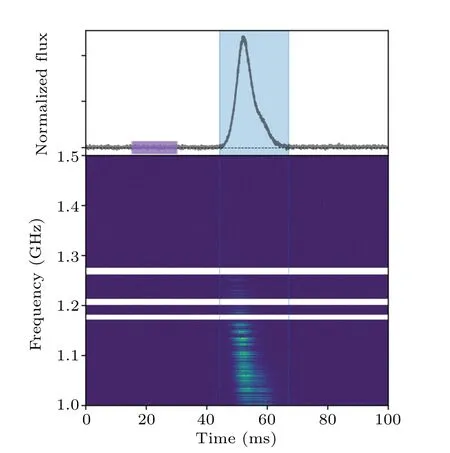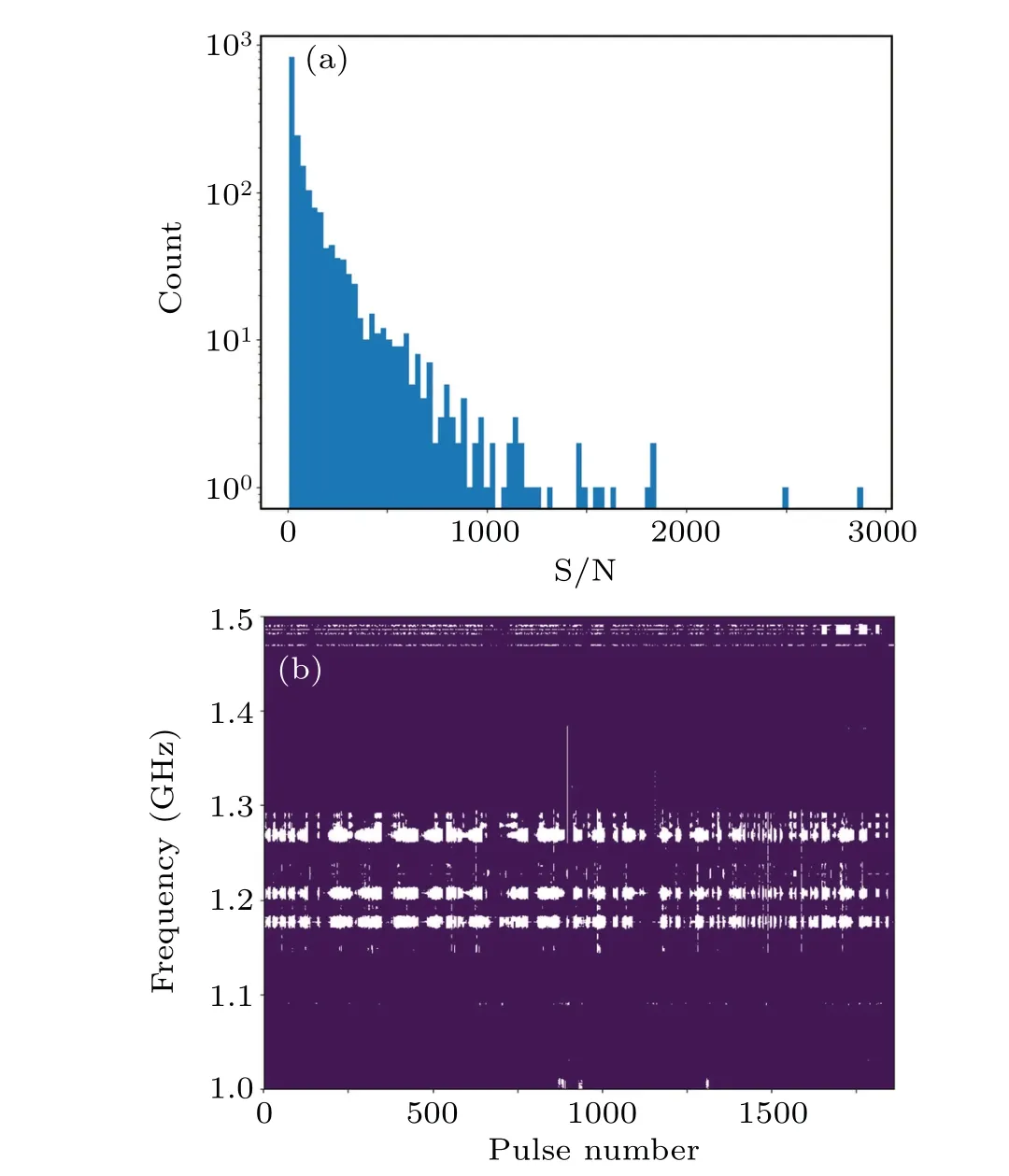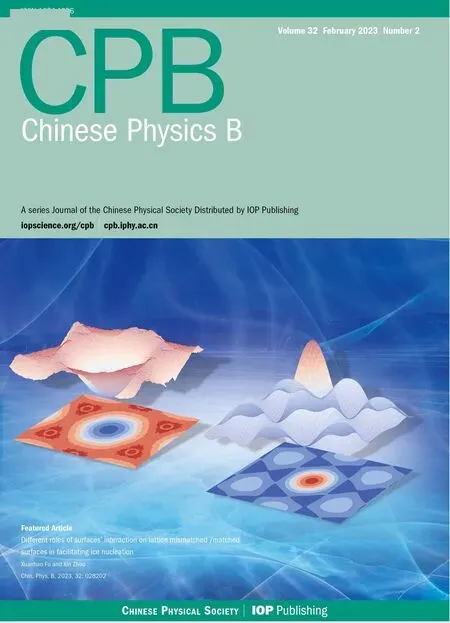Atlas of dynamic spectra of fast radio burst FRB 20201124A
Bo-Jun Wang(王鉑鈞) Heng Xu(胥恒) Jin-Chen Jiang(姜金辰) Jiang-Wei Xu(徐江偉)Jia-Rui Niu(牛佳瑞) Ping Chen(陳平) Ke-Jia Lee(李柯伽) Bing Zhang(張冰) Wei-Wei Zhu(朱煒瑋)Su-Bo Dong(東蘇勃) Chun-Feng Zhang(張春風(fēng)) Hai Fu(傅海) De-Jiang Zhou(周德江)Yong-Kun Zhang(張永坤) Pei Wang(王培) Yi Feng(馮毅) Ye Li(李曄)0 Dong-Zi Li(李冬子)Wen-Bin Lu(魯文賓) Yuan-Pei Yang(楊元培) R.N.Caballero Ce Cai(蔡策) Mao-Zheng Chen(陳卯蒸)Zi-Gao Dai(戴子高) A.Esamdin(艾力伊沙木丁) Heng-Qian Gan(甘恒謙)Jin-Lin Han(韓金林) Long-Fei Hao(郝龍飛) Yu-Xiang Huang(黃玉祥)Peng Jiang(姜鵬)Cheng-Kui Li(李承奎) Di Li(李菂) Hui Li(李輝) Xin-Qiao Li(李新喬) Zhi-Xuan Li(李志玄)Zhi-Yong Liu(劉志勇) Rui Luo(羅睿) Yun-Peng Men(門云鵬)0 Chen-Hui Niu(牛晨輝) Wen-Xi Peng(彭文溪)Lei Qian(錢磊) Li-Ming Song(宋黎明) Jing-Hai Sun(孫京海) Fa-Yin Wang(王發(fā)印) Min Wang(汪敏)Na Wang(王娜) Wei-Yang Wang(王維揚(yáng)) Xue-Feng Wu(吳雪峰)0 Shuo Xiao(肖碩)Shao-Lin Xiong(熊少林) Yong-Hua Xu(徐永華) Ren-Xin Xu(徐仁新) Jun Yang(楊俊) Xuan Yang(楊軒)0Rui Yao(姚蕊) Qi-Bin Yi(易祁彬) You-Ling Yue(岳友嶺) Dong-Jun Yu(于東俊) Wen-Fei Yu(余文飛)Jian-Ping Yuan(袁建平) Bin-Bin Zhang(張彬彬) Song-Bo Zhang(張松波)0 Shuang-Nan Zhang(張雙南)Yi Zhao(趙一) Wei-Kang Zheng(鄭偉康) Yan Zhu(朱巖) and Jin-Hang Zou(鄒金航)
1Kavli Institute for Astronomy and Astrophysics,Peking University,Beijing 100871,China
2National Astronomical Observatories,Chinese Academy of Sciences,Beijing 100101,China
3Department of Astronomy,Peking University,Beijing 100871,China
4University of Chinese Academy of Sciences,Chinese Academy of Sciences,Beijing 100049,China
5Department of Particle Physics and Astrophysics,Weizmann Institute of Science,Rehovot 76100,Israel
6Nevada Center for Astrophysics,University of Nevada,Las Vegas,NV 89154,USA
7Department of Physics and Astronomy,University of Nevada,Las Vegas,NV 89154,USA
8Department of Physics&Astronomy,University of Iowa,Iowa City,IA 52242,USA
9Zhejiang Laboratory,Hangzhou,Zhejiang 311121,China
10Purple Mountain Observatory,Chinese Academy of Sciences,Nanjing 210008,China
11TAPIR,Walter Burke Institute for Theoretical Physics,Mail Code 350-17,Caltech,Pasadena,CA 91125,USA
12Department of Astronomy,University of California at Berkeley,Berkeley,CA 94720,USA
13South-Western Institute For Astronomy Research,Yunnan University,Yunnan 650504,China
14Key Laboratory of Particle Astrophysics,Institute of High Energy Physics,Chinese Academy of Sciences,Beijing 100049,China
15Xinjiang Astronomical Observatory,Chinese Academy of Sciences,Urumqi 830011,China
16University of Science and Technology of China,Anhui 230026,China
17Yunnan Observatories,Chinese Academy of Sciences,Kunming 650216,China
18Guizhou Normal University,Guiyang 550001,China
19CSIRO Space and Astronomy,Epping,NSW 1710,Australia
20Max-Planck institut f¨ur Radioastronomie,Auf Dem H¨ugel,Bonn,53121,Germany
21School of Astronomy and Space Science,Nanjing University,Nanjing 210093,China
22State Key Laboratory of Nuclear Physics and Technology,School of Physics,Peking University,Beijing 100871,China
23Shanghai Astronomical Observatory,Chinese Academy of Sciences,Shanghai 200030,China
24Key Laboratory of Modern Astronomy and Astrophysics(Nanjing University),Ministry of Education,Nanjing 210093,China
25College of Physics,Hebei Normal University,Shijiazhuang 050024,China
Keywords: fast radio burst,FAST
1.Introduction
Fast radio bursts (FRBs) are bright, millisecond duration pulses with dispersion measures (DM) mostly well in excess of galactic values, since first discovered in 2007,[1]more than 800 FRBs have been detected so far and 27 of them can emit repeating bursts[3,4](https://www.hertaexperiment.org/frbstats/catalogue).Currently, 19 FRBs have been localized to host galaxies (https://frbhosts.org/).Although the physical mechanism of FRBs still remains unknown, FRB 200428[5-8]produced by galactic magnetar SGR J1935+2154 suggests that some of the FRBs can be emitted by magnetars.[2,9]Among all the FRBs,FRB 20201124A, which was discovered by CHIME,[10]has been frequently studied recently.Its radio bursts show rich pulse structures.[11,12]Through dynamic spectra, researchers investigated the scintillation time-scale of FRB 20201124A.[13]Efforts have also been made to localize its host galaxy.[14-17]
Dynamic spectra record the FRB intensity as a function of time and frequency.Dynamic spectra contain information of FRB intrinsic emission properties as well as density fluctuation of interstellar and inter-galactic medium.We noted that there is lack of a systematic collection of dynamic spectra for FRBs.In this paper, we present the dynamic spectra data of FRB 20201124A which covers 1863 pulses detected by our team.
2.Observation,data acquisition,and analysis
We used the Five-hundred-meter Aperture Spherical radio Telescope (FAST)[18]to monitor FRB 20201124A from April to June in 2021.The FAST 19-beam pulsar back-end covers 1.0-1.5 GHz in frequency band and has a system temperature about 20 K to 25 K.[19]The data were recorded using the digital back-end based on the Re-configurable Open Architecture Computing Hardware-2 (ROACH2) board[20]with temporal resolution of 49.152μs or 196.608μs and frequency resolution of 122.07 kHz.
Our data processing contains two major steps, searching for single pulses and post processing to form the dynamic spectra.Firstly, we searched for the FRB candidates offline with software package TRANSIENTX.Frequency channels affected by radio frequency interference (RFI) were removed.The data were de-dispersed in the dispersion measure (DM)range of 380-440 cm-3·pc with a step of 0.1 cm-3·pc since FRB 20201124A is a known repeater.The pulse width was searched from 0.1 ms to 100 ms in the box-car-shaped matched filter.3364 candidates with a S/N threshold larger than 7 were plotted and visually inspected.
In the post processing phase,we used the software package DMPHASE to further refine the DM.The DMPHASE uses the Fourier-domain method,where DM is found by maximising the time derivative of the normalized“intensity”.To measure the intensity, the polarisation calibration was then performed with software package PSRCHIVE.[21]We adopted the single axis model in polarisation calibration,where the differential gain and phase between the two polarisation channels are calibrated with the injected noise signal.To reduce the dynamic spectra to a manageable size, we integrated over time and frequency to reduce the resolution.The frequency and time resolutions of the final dynamic spectra are~1.0 MHz and~0.2 ms, respectively.We stored the data in the PSRFITS[21]format, which is widely used in the community of pulsar astronomy.
3.Data format and contents of the library
The PSRFITS format is based on the Flexible Image Transport System(FITS)(https://fits.gsfc.nasa.gov/).[22]According to FITS standards,a PSRFITS file consists of a primary headerdata unit(HDU)followed by a series of extension HDUs.[21]As for our data,the primary HDU contains basic information such as telescope name and its location,source location,observation time,etc.Four extension HDUs,which are in a binary table format,contain specific information related to the observation:processing history,pulsar ephemeris,tempo2 predictor and the pulsar data.Notice that several PSRFITS files contain more than one burst because the interval between their time of arrivals(TOAs)is quiet small.
We associate each pulse with a mask file.The mask file,formatted in plain ascii file, contains two rows of data.The first row consists two integer numbers corresponding to the boundary of pulse on-phase in the profile.The second row of mask file shows where the baseline lies in.Figure 1 shows the dynamic spectrum of pulse No.12 as an example.

Fig.1.Example of pulse profile (upper panel) and dynamic spectra(lower panel).Purple box and blue area in the pulse profile show the baseline and pulse on-phase definition.White strips in the dynamical spectra indicate the removed channels due to the RFI.
4.Statistics of data properties
Our detection threshold was a signal-to-noise ratio S/N>7,and 1103 bright bursts reached S/N>30 among a total of 1863 detected bursts.Figure 2(a)shows the S/N distribution of all detected bursts.Figure 2(b) shows the distribution of removed channel in frequency band.Usually, a few percent frequency channels had been removed due to the RFI.
The sample completeness was determined with the following method.We simulated 10000 mock bursts with Gaussian profile and bandpass matching the detected distributions.We then randomly injected the mock bursts into the original FAST data when no FRB was detected.The mock burst injected data were then fed to our burst-searching pipeline to compute the detection rate.The procedure showed that the fluence threshold achieving the 95%detection probability with S/N≥7 is 53 mJy·ms.[11]
Parameters of each burst(including burst MJD,S/N,DM,etc)are available in the data availability section of Ref.[11].

Fig.2.(a)The S/N distribution of 1863 pulses.(b)The distribution of RFI zapping for all data.
5.Conclusion
In this work, we present a collection of dynamic spectra for 1863 FAST-detected radio bursts of FRB 20201124A during April to June in 2021.This is the largest burst sample detected in any FRB so far.
The signal of FRB 20201124A is highly polarised.[11]Our dynamic spectra is polarisation calibrated.Previous study shows that 0.5%polarisation fidelity can be achieved with the current calibration method.[3]
The current data set is of high S/N, where 5%, 30%and 67% data had S/N≥560.63, 116.02, and 23.85, respectively.Simulation is used to determine the completeness of burst detection,where 95%completeness fluence threshold is 53 mJy·ms.
For each burst, we provide one PSRFITS file and one mask file.We provide the total intensity data in PSRFITS format,and mask file in ascii format which labels the burst.
Data availability and related softwares
The data that support the findings of this study are openly available in Science Data Bank at https://www.doi.org/10.57760/sciencedb.j00113.00076.The related software can be found in the corresponding repositories.
TRANSIENTX:https://github.com/ypmen/TransientX
DMPHASE:https://www.github.com/DanieleMichilli/DM
phase PSRCHIVE: http://psrchive.sourceforge.netAcknowledgements
This work made use of data from the FAST.FAST is a Chinese national megascience facility, built and operated by the National Astronomical Observatories, Chinese Academy of Sciences.We acknowledge the use of public data from the Fermi Science Support Center(FSSC).This work is supported by the National SKA Program of China (Grant Nos.2020SKA0120100 and 2020SKA0120200), the National Natural Science Foundation of China (Grant Nos.12041304, 11873067, 11988101,12041303, 11725313, 11725314, 11833003, 12003028,12041306,12103089,U2031209,U2038105,and U1831207),the National Key Research and Development Program of China (Grant Nos.2019YFA0405100, 2017YFA0402602,2018YFA0404204, and 2016YFA0400801), Key Research Program of the Chinese Academy of Sciences (Grant No.QYZDJ-SSW-SLH021), Natural Science Foundation of Jiangsu Province (Grant No.BK20211000), Cultivation Project for FAST Scientific Payoff and Research Achievement of CAMS-CAS, the Strategic Priority Research Program on Space Science, the Western Light Youth Project of Chinese Academy of Sciences (Grant Nos.XDA15360000,XDA15052700, and XDB23040400), funding from the Max-Planck Partner Group, the science research grants from the China Manned Space Project (Grant Nos.CMS-CSST-2021-B11 and CMS-CSST-2021-A11), and PKU development (Grant No.7101502590).KJL acknowledges support from the XPLORER PRIZE.BBZ is supported by Fundamental Research Funds for the Central Universities (Grant No.14380046) and the Program for Innovative Talents, Entrepreneur in Jiangsu.
- Chinese Physics B的其它文章
- Analysis of cut vertex in the control of complex networks
- Investigating the characteristic delay time in the leader-follower behavior in children single-file movement
- Micro-mechanism study of the effect of Cd-free buffer layers ZnXO(X =Mg/Sn)on the performance of flexible Cu2ZnSn(S,Se)4 solar cell
- Thermally enhanced photoluminescence and temperature sensing properties of Sc2W3O12:Eu3+phosphors
- Heterogeneous hydration patterns of G-quadruplex DNA
- Analysis of refraction and scattering image artefacts in x-ray analyzer-based imaging

